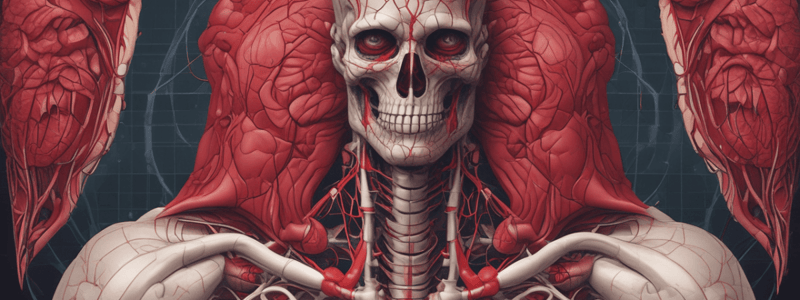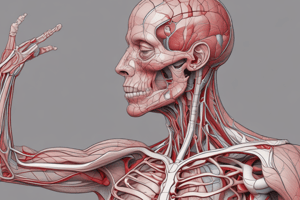Podcast
Questions and Answers
Which blood vessel receives blood from the left ventricle and distributes it to the body?
Which blood vessel receives blood from the left ventricle and distributes it to the body?
- Inferior Vena Cava
- Aorta (correct)
- Superior Vena Cava
- Pulmonary Veins
What is the function of the Sinoatrial (SA) Node?
What is the function of the Sinoatrial (SA) Node?
- To distribute oxygen-rich blood to the body
- To drain blood from the heart muscles
- To pump blood from the heart
- To regulate the heartbeat (correct)
During which phase of the cardiac cycle does the atria fill with blood?
During which phase of the cardiac cycle does the atria fill with blood?
- Systole
- Diastolic pressure
- Systolic pressure
- Diastole (correct)
What is the normal systolic blood pressure?
What is the normal systolic blood pressure?
Which veins bring oxygen-rich blood from the lungs to the left atrium?
Which veins bring oxygen-rich blood from the lungs to the left atrium?
What is the function of the Atrioventricular (AV) Node?
What is the function of the Atrioventricular (AV) Node?
What is the function of the pericardial fluid?
What is the function of the pericardial fluid?
What is the thickest layer of the heart?
What is the thickest layer of the heart?
What is the purpose of the fossa ovalis?
What is the purpose of the fossa ovalis?
What is the function of the papillary muscles?
What is the function of the papillary muscles?
What is the name of the valve between the right atrium and right ventricle?
What is the name of the valve between the right atrium and right ventricle?
What is the purpose of the semilunar valves?
What is the purpose of the semilunar valves?
What is the name of the large blood vessel that receives blood from the right ventricle?
What is the name of the large blood vessel that receives blood from the right ventricle?
What is the name of the layer that faces the pericardial cavity?
What is the name of the layer that faces the pericardial cavity?
What is the purpose of the chordae tendineae?
What is the purpose of the chordae tendineae?
What is the name of the muscle that helps with contraction in the right atrium?
What is the name of the muscle that helps with contraction in the right atrium?
What is the approximate size of the heart?
What is the approximate size of the heart?
What is the term for the space that holds the heart?
What is the term for the space that holds the heart?
What is the direction of the apex of the heart?
What is the direction of the apex of the heart?
What is the layer of serous pericardium that attaches to the heart?
What is the layer of serous pericardium that attaches to the heart?
What is the purpose of the pericardial fluid?
What is the purpose of the pericardial fluid?
In which intercostal spaces is the heart located?
In which intercostal spaces is the heart located?
Flashcards are hidden until you start studying
Study Notes
Location and Structure of the Heart
- Located within the mediastinum (inferior), between the 2nd and 5th intercostal spaces
- 2/3 of its mass lies to the left of the body midline
- Size: approximately 12 cm (5 inches) in length, 9 cm (3.5 inches) in width, and 6 cm (2.4 inches) in thickness
- Shape: blunt cone, with the apex directed anteriorly and the base directed posteriorly
Pericardium
- Fibrous pericardium: dense, irregular connective tissue
- Serous pericardium:
- Parietal layer: lines the fibrous pericardium
- Visceral layer (epicardium): covers the heart
- Pericardial cavity: filled with pericardial fluid, which reduces friction between the heart and surrounding tissues during contraction and relaxation
Layers of the Heart
- Epicardium (visceral layer of serous pericardium):
- Faces the pericardial cavity
- Composed of mesothelium and delicate connective tissue
- Myocardium:
- Thickest layer
- Composed of cardiac muscle and blood vessels
- Unique cardiac muscle tissue with branching cardiocytes and intercalated disks
- Endocardium:
- Endothelium bound to the myocardium by subendothelial connective tissue
- Contains part of the cardiac conduction system
Heart Chambers
- 2 Atria:
- Right atrium
- Left atrium
- Separated by the interatrial septum
- Fossa ovalis: a remnant of the foramen ovale in the fetal heart
- 2 Ventricles:
- Right ventricle
- Left ventricle
- Separated by the interventricular septum
- Papillary muscles: attached to tendon-like structures called chordae tendineae
Heart Valves
- 2 Atrioventricular (AV) valves:
- Tricuspid valve (right AV): between the right atrium and right ventricle
- Bicuspid valve (mitral or left AV): between the left atrium and left ventricle
- 2 Semilunar valves:
- Pulmonary valve (right semilunar): between the right ventricle and pulmonary trunk
- Aortic valve (left semilunar): between the left ventricle and aorta
Blood Flow
- Blood leaving the heart:
- Pulmonary trunk: receives blood from the right ventricle and sends it to the lungs for oxygenation
- Aorta: receives blood from the left ventricle and distributes it to the body
- Blood entering the heart:
- Right atrium: receives blood from the superior and inferior vena cavae and the coronary sinus
- Left atrium: receives blood from the pulmonary veins
Cardiac Conduction System
- Specialized cells found within the endocardium
- Sinoatrial (SA) node: the "pacemaker" of the heart, responsible for regulating heart contractions
- Internodal pathways: send signals to the right and left atria
- Atrioventricular (AV) node: relays signals from the SA node to the ventricles
- Atrioventricular (AV) bundle or bundle of His: splits into the right and left bundle branches
- Purkinje fibers: initiate contraction of the ventricles
Cardiac Cycle
- Diastole:
- Heart is at rest
- Atria fill with blood
- AV valves are open, and semilunar valves are closed
- Systole:
- Atria contract
- AV valves are open, and semilunar valves are closed
- Ventricles contract
- AV valves are closed, and semilunar valves are open
Blood Pressure
- Systolic blood pressure: pressure of blood in the vessels when the heart is contracting
- Normal: 120 mm Hg
- High: > 130 mm Hg
- Low: < 90 mm Hg
- Diastolic blood pressure: pressure of blood in the vessels when the heart is at rest
- Normal: 80 mm Hg
- High: > 90 mm Hg
Studying That Suits You
Use AI to generate personalized quizzes and flashcards to suit your learning preferences.





